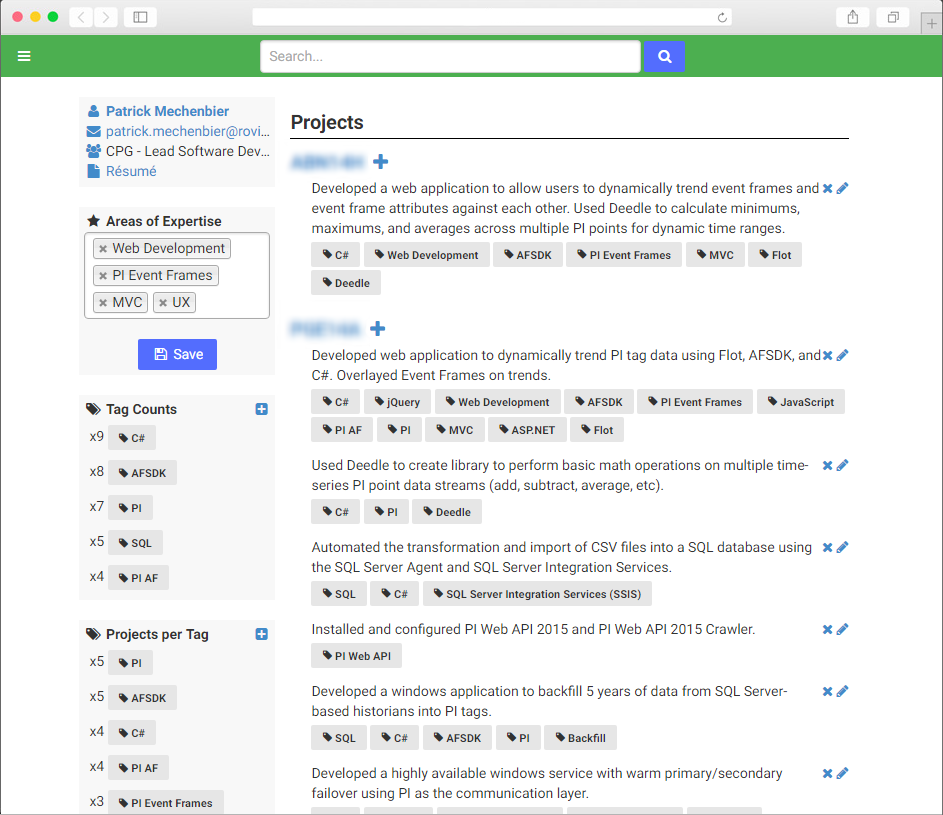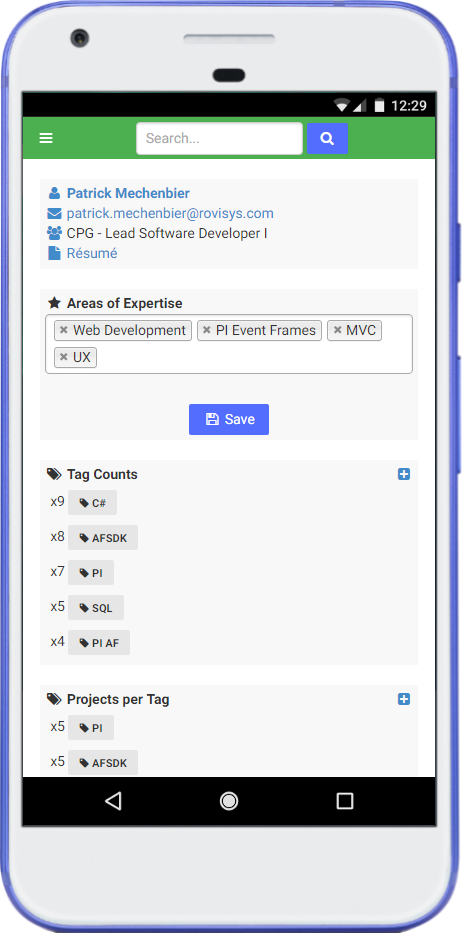Talent Scout
About The Project
As RoviSys grew, it became hard to remember who enjoyed working with various technologies and platforms, let alone who had experience solving specific problems. Talent Scout is a knowledge management system designed to help improve office collaboration and knowledge sharing. Talent Scout facilitates actions that will help peers work smarter, not harder.
My Role
As a project developed in my free time, I was responsible for the project as a whole - I wear the hats of Product Manager, Design, Developer, and support. I led other developers who were interested in contributing to the project.
The Challenge
As RoviSys grew, the days where you could remember everyone's name and what projects they've worked as well as their experience quickly faded. Siloed groups and project teams found it hard to connect with one another and would duplicate work without knowing it. Hours would be spent attempting to figure out an issue, only to find afterwards a coworker we didn't interact with too often had a wealth of knowledge and experience in the subject and could have solved it in a few minutes.
Talent Scout was built to solve these challenges - to foster easier connections with knowledgeable coworkers, foster reuse, and improve the sharing of knowledge - problems that weren't unique to RoviSys.
The Process
Ideation & Background
After a long day onsite, a few RoviSys employees and myself were talking while packing up before going home. We were frustrated that we spent the majority of the day troubleshooting small problems, only to be told after they fixed the problems that someone back in the office had loads of experience and could have helped fix the issues in minutes. The discussion soon turned to "how could we prevent this in the future?"
The basic tenents of Talent Scout were born at this time. It would take just over a year before the first version of the software went live.
Research
Before I implemented any software or wrote a single line of code, I needed to understand the existing systems within RoviSys and how they communicated within one another. If our problems could be solved by an existing system, I didn't want to create another system that had to be maintained by myself or IT.
I also talked to other RoviSys engineers and developers to understand what their needs would be for a talent management system. This invaluable round of user research allowed me to find issues that I would never have thought of - issues that could also be solved by a talent management system. I also defined typical tasks and workflows for such a system.
After taking stock of our IT resources and talking to users, it was decided that the features we wanted in Talent Scout could not effectively be implemented in an existing system. We then turned to looking at off-the-shelf knowledge management software, but quickly found that there wasn't a solution that met all of our functional requirements.
Design & Testing
Initial designs included entity relationship diagrams and paper wireframes. The entity relationship diagrams allowed me to understand how the data in the system was connected, which allowed me to create a mental model. This mental model made it extremely easy to figure out what pieces of information needed to be displayed on each screen within the application.
Once wireframes were completed for each main page in the application, I sat down with a few users and asked them to complete a few tasks while looking at the wireframes and talking themselves through the process. If a user got held up in a task, it was an indication that a wireframe was missing a piece of information needed to complete the task. This process took a few iterations before the wireframes and database design were completed.
The Solution
Many ideas were floated to try and solve this problem, but in the end it was decided that we should build the software ourselves. Developing custom software has many advantages, but the biggest one for RoviSys was the ability to build an end product that kept the user and existing RoviSys tools and systems in mind. We were able to build a product that fit with how we function as a company.
Each week, users enter a few key points about any interesting problems they've encountered and solved while working into Talent Scout. We tag these write-ups with technologies related to the write-up to allow for easy searching. I made sure this process was easy and that it wouldn't take more than a few minutes each week. Over time, a searchable repository of who has worked with certain technologies and the context in which those technologies were used is created.
Now, Talent Scout can then be used by anyone within the company who has a question regarding a particular technology:
- A Manager looking for an SME to sit in on a call with a prospective customer
- A Project Manager can ask an SME to review the technology portion of a proposal for validity
- An Engineer looking for guidance with a particular subject
- A Project Manager looking for a resource for an upcoming project
Because RoviSys engineers work in the office and onsite, I used responsive design to optimize the application for mobile and desktop use, for fast, easy connections. Latest technologies are used throughout the site for improved performance and usability.


I designed and built the software in my free time (mostly nights and weekends). Developing Talent Scout has allowed me to fuel my passion of creating useful tools that solve a real problem, all while enhancing the efficiency of the business.
Results
Since going live Talent Scout has helped:
- Foster innovation by encouraging the free flow of ideas
- Improve decision making
- Improve customer service by streamlining response time
- Boost revenues by getting products, projects, and services completed faster
- Recognize and utilize employees' knowledge
- Streamline operations and reduce costs by eliminating redundant or unnecessary processes
The above results have been noticed in less than a year since the release of Talent Scout within RoviSys. As more users participate over time, the knowledge base will become populated with more information, allowing RoviSys to realize the above results more often.